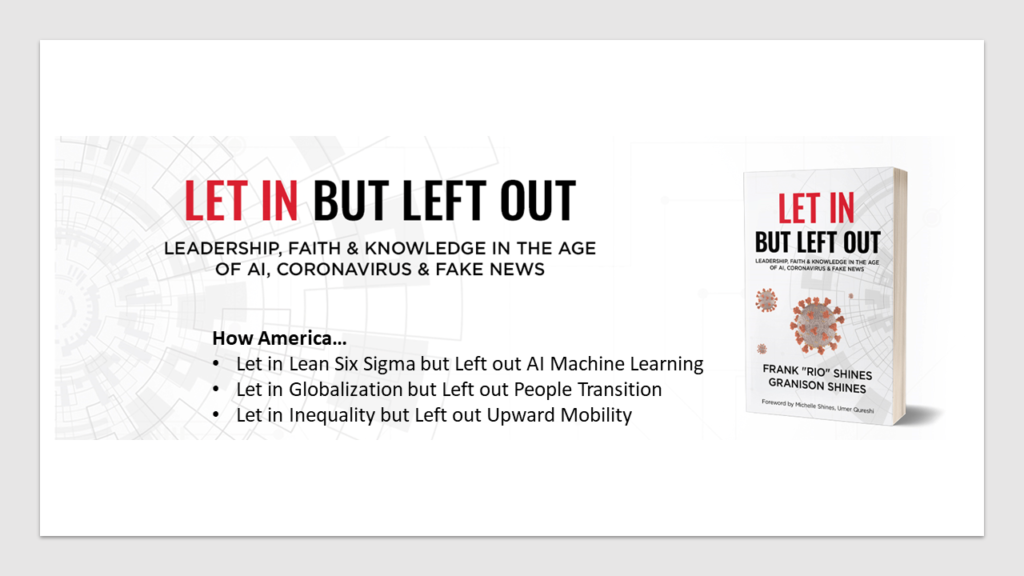Let in but Left Out: Lean Six Sigma in the Age of AI
Let in But Left Out, the new 2020 book by Frank Shines, posits that the future of Lean Six Sigma is the AI Machine Learning Black Belt.
Let in But Left Out: AI-Powered Lean Six Sigma Way
In Let in But Left Out, my brother Granison and I teamed up to explain how to solve complex problems like the coronavirus outbreak. It doesn’t matter if I am working with a tech startup, a small business, a Fortune 500 corporation, a military service branch or on a coronavirus pandemic problem, I must always listen to lots of people and follow the evidence using data and intuition. This means I draw upon both art and science: the art of listening, social psychology and human cooperation, communication, persuasion, imagination and innovation; and the science of data, facts, processes and technologies.
Below is an excerpt from the book, Let in But Left Out: Leadership, Faith & Knowledge in the Age of AI, Coronavirus & Fake News.
Since we all learn best by doing, let’s jump right into the most real-life problem that we are all facing today — the novel coronavirus outbreak.
Rather than explaining a bunch of concepts and principles, I am going to show you how I would use the tools and apply the methods to solve the coronavirus problem. To make this accessible and understandable to the layperson, I will simplify many of the complex concepts.
Over the past 25 years I’ve worked with many of the major pharmaceutical, biologics and medical device companies in the USA and other nations to improve their business processes, analyze their data and roll out their enterprise technology systems. Recently, I’ve spent a good amount of time in biological laboratories, or biolabs, learning from the subject matter experts.
We will apply the scientific method to examining the coronavirus pandemic, using the DMAIC approach: Define, Measure, Analyze, Improve, and Control. Bill Smith and Dr. Mikel Harry developed this system, called Six Sigma, at Motorola in the 1980s. With DMAIC, we will Define the problem, Measure the current state, Analyze the root causes, Improve the process (testing on a small scale where possible), Control the gains and share lessons learned.
Because we are in the midst of the pandemic, we will not be able to fully complete this project as events evolve and data changes. For this reason, we have created a web page where updates will be provided:
https://www.letinbutleftout.com/covid-19-dmaic/
Let in But Left Out: New Skills for Lean Six Sigma
Lean Six Sigma Green Belts and Black Belts have the requisite process analysis and statistical analysis competencies upon which they can develop skills for the future. Once you have identified your personal Purpose (as outlined in the book, Let in but Left Out) then it is time to move to the second step: Action. Action contains four parts, all related: Knowledge, Attitude, Skills and Habits.
- Knowledge is what you know. More specifically, it includes the ongoing pursuit and the wise and practical application of your knowledge. Lean Six Sigma professional must better understand the psychology of change and the practical application of digital transformation, artificial intelligence and machine learning methods.
- Attitude is how you feel about what you know. In a world of uncertainty and change from COVID-19 to tech disruption and globalization, you must be flexible, adaptable, comfortable with ambiguity and willing to change.
- Skills are what you have. They are your innate talents and proficiencies you have developed. Key skills for the future include proficiency or mastery of one or more of the following: R (Studio), Python, Jupyter Notebooks, Scikit Learn, Microsoft Azure Machine Learning Studio, Google Cloud AI Platform, Amazon AI Platform; and Deming’s System of Profound Knowledge, Dr. Flint McGlaughlin’s Conversion Sequence and Funnel of Micro-Yes‘s, Jona Berger’s R-E-D-U-C-E method as outline in his new book, Catalyst: How to Change Anyone’s Mind.
- Habits are what you do with what you have. “To be successful you don’t need to do extraordinary things; you just need to do ordinary things extraordinarily well,” said Jim Rohn. Get plenty of sleep, don’t take anything (including yourself) too seriously, get up early, be nice, help others, have fun, learn lots, love others.
Knowledge
Knowledge is what you know. “There is no substitute for knowledge,” pronounced Deming (the “Father of Quality”). During speeches and at his world-famous four-day seminars, Deming would remind his audiences that information is not knowledge. He often spoke of the need to improve education, noting that students memorize information, but they do not learn how to think. When visiting companies to help them improve their operations, Deming would observe volumes of data tables and say, “Tons of figures – no knowledge.” [177]
In a practical sense there are three levels of knowledge: Basic Knowledge, Advanced Knowledge and Profound Knowledge. Basic knowledge is the knowledge we acquire to become gainfully employed. We start collecting basic knowledge at an early age. The baby learns her parent’s face and voice; learns hot from cold; learns to talk and walk. As a child, she goes on to learn math, reading, writing, our history and our culture. As a young adult, she now graduates from high school or college with the basic knowledge needed to enter military service or secure a civilian job in order to pay the bills, travel, socialize, and maybe save a little. This basic knowledge used to be enough knowledge to get you through to retirement age. But as we will see, the requisite level of basic knowledge needed to earn a living wage today has soared.
For more information go to LetinbutLeftout.com or to purchase the 99 cents ebook on Amazon Kindle.

